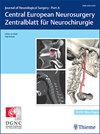Comment to the article: Magnetic resonance spectroscopic imaging for visualization of the infiltration zone of glioma.
Central European Neurosurgery
Pub Date : 2011-05-01
Epub Date: 2011-05-04
DOI:10.1055/s-0030-1254104
引用次数: 6
Abstract
The authors present a series of twenty patients with gliomas grade II and III examined by 1H-MRSI. Metabolic maps were correlated to areas of hyperintensity on T2 weighted MR images. In all cases the authors found the area of signal abnormalities as identifi ed by MRSI to be greater then the T2w hyperintense area. Stereotactic biopsies were obtained from areas detected by MRSI only and were found to contain tumor cells. This study suggests greater sensitivity of MRSI at defi ning infi ltrating tumor than signal aberrations obtained from the t2 weighted MR image. The observations of the authors are interesting. However, I worry that MRSI and Chemical Shift Imaging (CSI) as used in the present study leads to an overestimation of the area of true metabolic aberration, as compared to the t2-weighted MRI. The respective resolutions of t2weighted MR imaging and CSI are far from the same. CSI suff ers from partial volume eff ects and contamination from adjacent tissue as a direct consequence of its low resolution. Furthermore, error propagation due the post-processing algorithm with smoothing by interpolation is an additional confounder for interpreting the extent of signal abnormality as defi ned by CSI. In my mind the authors’ results may therefore simply be due to the lower spatial resolution of CSI compared to t2 weighted MRI. Their images in fi gures 1 and 2 substantiate this critique. In Fig. 1c and Fig. 2c the areas of CSI abnormality clearly encompasses CSF in the midline sulci and in the ventricles, respectively. If post-processing with smoothing of the CSI maps were only related to infi ltrated tissue, the CSI map would have to exclude regions which contain CSF, such as the ventricle. The graph in Fig. 3 may consequently be taken to demonstrate diff erences in resolution of both methods. I’m also hesitant to follow that stereotactic biopsies provide evidence for the apparent area of CSI abnormality to be accurate, since infi ltrating glioma cells can usually be found centimetres outside the tumor visible on imaging.对文章的评论:磁共振波谱成像对胶质瘤浸润区的可视化。
本文章由计算机程序翻译,如有差异,请以英文原文为准。
求助全文
约1分钟内获得全文
求助全文

 求助内容:
求助内容: 应助结果提醒方式:
应助结果提醒方式:


